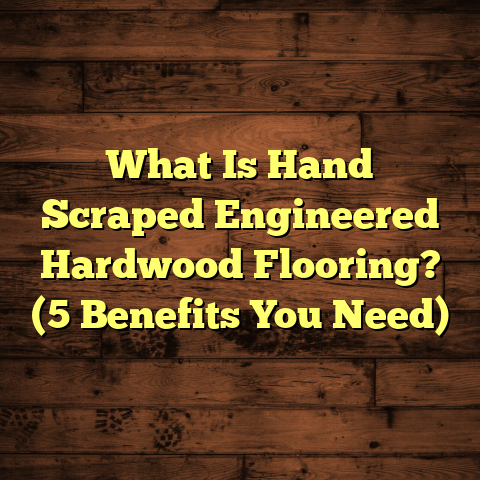What is Stranded Bamboo Flooring? (5 Benefits You Must Know!)
Imagine walking into a room and feeling the solid, smooth surface beneath your feet. The floor catches the light just right, revealing subtle grains and warm tones. There’s a quiet strength to it—something that says this isn’t just beautiful, it’s built to last. That kind of feeling is what I want for anyone who cares about their home’s flooring. Over many years of installing floors and advising homeowners, one material I keep coming back to is stranded bamboo flooring. It’s tough, eco-friendly, and offers a unique look that blends well in just about any space.
I know there’s a lot of flooring options out there. Hardwood, laminate, vinyl—they all have their place. But stranded bamboo has some qualities that make it stand out in a crowd. So today, I want to share everything I’ve learned about it—what it is, why it’s special, and how you can get the most from it in your home.
What is Stranded Bamboo Flooring?
At its core, stranded bamboo flooring is a kind of engineered bamboo floor. But unlike traditional bamboo flooring that uses long strips or planks laminated together, stranded bamboo takes bamboo fibers—kind of like shredded bamboo—and compresses them under heat and pressure with adhesives. This creates a dense, solid board that’s incredibly strong.
Think of it as taking the best parts of bamboo—the natural strength of the fibers—and packing them tightly into a plank that resists dents, moisture, and movement better than many hardwoods.
The process works like this:
- Bamboo stalks are harvested and cut down.
- Instead of slicing them into strips for conventional bamboo flooring, they’re shredded into strands.
- These strands are mixed with strong adhesives.
- Under intense heat and pressure, the mixture is compressed into dense planks.
- The planks are then finished with stains or protective coatings.
This construction makes stranded bamboo floors more dimensionally stable. That means they’re less likely to expand or contract with changes in humidity or temperature. For homes in regions with damp basements or fluctuating climates, this can be a huge advantage.
To give you an idea of how this compares: traditional solid bamboo flooring uses vertical or horizontal grain layers glued together. Those layers can sometimes separate if moisture gets in. Stranded bamboo’s fiberboard construction reduces this risk.
When I first installed stranded bamboo flooring for a family with an active toddler and two dogs, I was impressed by how well the floor held up under heavy play and paw traffic. The family loved that they had an eco-friendly option without sacrificing durability.
Why Bamboo?
Bamboo itself is often called a “grass,” but it behaves like wood when processed for flooring. It grows fast—much faster than trees—and can be harvested sustainably every 5-7 years without killing the plant. That fast growth cycle makes bamboo a renewable resource compared to hardwoods like oak or maple, which take decades to mature.
The environmental benefit is huge when you consider how much wood flooring contributes to deforestation worldwide. Bamboo offers an alternative that still delivers a natural look and feel.
5 Benefits You Must Know About Stranded Bamboo Flooring
Alright, let’s get into the nuts and bolts—the five key benefits that make stranded bamboo flooring worth thinking about.
1. Unmatched Durability and Hardness
One of the first things people worry about with flooring is how well it will hold up over time. Scratches from pets, dents from dropped objects, wear from high foot traffic—these are common concerns.
Stranded bamboo flooring scores impressively high on the Janka hardness scale—a standard test that measures wood’s resistance to denting and wear. Typical hardwoods like red oak score around 1,290 pounds-force (lbf). In contrast, stranded bamboo can score anywhere from 3,000 to 3,700 lbf depending on the manufacturing process and density.
This makes it harder than many tropical hardwoods used in flooring. What does this mean for you? Your floors will resist dents and scratches better, maintaining their beauty longer.
I recall working on a commercial project where they needed floors that could endure heavy equipment and constant foot traffic. Stranded bamboo was chosen precisely because of its toughness. After a few years, the floor looked nearly as good as new.
That durability also translates well in residential settings. Families with kids or pets often tell me their floors handled rough use without showing wear like other floors did before.
2. Environmentally Friendly Choice
If you care about sustainability—and I know many people do—bamboo flooring is a smart pick.
Bamboo grows incredibly fast compared to traditional hardwood trees—up to several feet per day in some species! It matures in about 5-7 years versus 20-50 years for many hardwood trees. This rapid growth means bamboo forests can be harvested frequently without deforestation risks.
Stranded bamboo utilizes crushed fibers from the whole plant, not just strips of stalks. This efficient use of material reduces waste in production.
Many manufacturers also source their bamboo responsibly from managed plantations and use adhesives with low volatile organic compounds (VOCs), which means better indoor air quality after installation.
When I talk to clients interested in green building or sustainable living, this aspect often seals the deal for them. They want floors that look good but also align with their values about protecting the planet.
3. Strong Resistance to Moisture and Climate Changes
Wood floors are notorious for reacting badly to moisture changes—they can swell, warp, cup, or develop gaps when humidity fluctuates.
Stranded bamboo’s construction gives it more dimensional stability. Because the fibers are compressed tightly with adhesives, there’s less room for water to get in and cause expansion or contraction.
This makes stranded bamboo floors suitable for areas where traditional hardwood might struggle—like kitchens, basements (if moisture is controlled), or bathrooms (with proper finishes).
I installed stranded bamboo flooring in a lakeside cabin where humidity swings were common throughout the year. The owners reported zero problems with warping or gaps even after three winters and summers of changing conditions.
4. Aesthetic Versatility
When people think “bamboo floors,” they often imagine light-colored planks with a uniform grain pattern. While traditional bamboo can look like that, stranded bamboo offers much more variety.
Because the planks are fiberboard-based, manufacturers can apply different stains and finishes—everything from natural honey tones to dark espresso or gray washes.
Textures vary too: hand-scraped surfaces add rustic charm; wire-brushed finishes reveal deeper grain detail; smooth finishes provide modern elegance.
Widths range from narrow strips to wide planks over 7 inches across—giving you freedom in design style whether you prefer classic hardwood looks or something more contemporary.
One memorable project was for a client wanting a Scandinavian-inspired living room with wide gray-stained planks. We found stranded bamboo options that matched perfectly while staying within her budget.
5. Cost-Effective Without Sacrificing Quality
Flooring budgets can be tricky. Hardwood floors are beautiful but often pricey both for materials and installation. Laminate may be cheaper upfront but doesn’t last as long or wear as well.
Stranded bamboo flooring hits a sweet spot between price and performance. Material costs typically run from $4 to $8 per square foot depending on quality and finish. Installation costs vary by region but tend to be similar to hardwoods.
Compared to exotic hardwoods that can cost $10+ per square foot, stranded bamboo offers excellent value for durability and style.
In my experience, clients appreciate this balance because they get floors that look premium but don’t break the bank—plus lower maintenance costs over time thanks to the material’s toughness.
Insider Tips From My Flooring Projects
Here are some practical pointers I’ve picked up over years installing stranded bamboo floors:
Don’t Skimp on Quality
Stranded bamboo quality varies widely among brands and manufacturers. Cheap products may use inferior adhesives or finishes that wear quickly or emit higher VOCs.
Look for reputable brands with certifications like FSC (Forest Stewardship Council) or FloorScore (indoor air quality). These guarantees matter when investing thousands into your floors.
I once repaired a customer’s floor after just two years because the original product delaminated—something that could’ve been avoided by choosing certified flooring upfront.
Acclimate Your Flooring Properly
Like all wood-based floors, stranded bamboo needs time to adjust to your home’s humidity and temperature before installation.
I advise leaving unopened boxes in the room for at least 72 hours before installation begins. This step prevents expansion or contraction issues later.
Skipping acclimation can lead to gaps forming between planks or buckling shortly after install—both costly problems to fix.
Use a Good Underlayment
Underlayment plays multiple roles: cushioning underfoot, sound absorption, moisture barriers over concrete slabs.
For installations over concrete or in basements, I insist on underlayments with vapor barriers. It protects your floor from moisture seeping upward which could damage glue lines or cause swelling.
I’ve seen jobs where underlayment was overlooked—resulting in mold growth under the floorboards—a nightmare scenario avoided with proper prep work.
Clean With Care
Stranded bamboo floors are durable but not invincible. Dirt and grit can scratch surfaces if not regularly cleaned.
Use soft brooms or vacuums designed for hardwood floors so you don’t damage the finish. Avoid harsh chemicals; stick to pH-neutral cleaners recommended by manufacturers.
Wet mopping should be done sparingly—excess water can seep into seams if not sealed perfectly and cause damage over time.
Consider Professional Installation
While many homeowners tackle DIY floor installs successfully, professional installers bring precision tools and experience that make a difference in longevity and appearance.
I’ve fixed many floors installed poorly by amateurs—uneven seams, uneven expansion gaps, poorly glued boards—that led to major issues later on.
Hiring experienced installers ensures your floor is laid perfectly flat, seams align tightly, and expansion gaps are correct according to climate conditions.
In-Depth Look: The Science Behind Stranded Bamboo Strength
Here’s where things get interesting if you like understanding why materials perform as they do.
Bamboo fibers have a tensile strength similar to steel in some cases—meaning they’re incredibly strong for their weight. When these fibers are crushed and glued under heat/pressure into boards, they create a composite material similar in concept to engineered wood but denser and harder.
Tests show:
- Stranded bamboo floors resist indentation forces over twice as well as red oak.
- Scratch resistance exceeds many hardwood species by 20-30%.
- Water absorption rates are significantly lower due to tight fiber bonding.
- Dimensional movement (expansion/contraction) is reduced by up to 50% compared to solid hardwood boards under fluctuating humidity cycles.
These properties explain why stranded bamboo performs so well even in tougher environments where regular wood struggles.
Real-Life Case Studies: Success Stories With Stranded Bamboo Flooring
Case Study 1: Family Home With Kids & Pets
A busy family of five wanted durable floors for their open-plan living area where kids played constantly and dogs ran around freely. They chose stranded bamboo because it promised hardness plus style without chemicals harmful to children or pets.
After three years:
- No major dents or scratches visible.
- Minimal maintenance needed beyond regular sweeping.
- The natural finish still looked fresh despite heavy use.
- They appreciated how easy spills cleaned up without warping or staining.
This project confirmed what I’d seen elsewhere: stranded bamboo balances beauty with practicality perfectly for active households.
Case Study 2: Coastal Vacation Home
A vacation property near the ocean faced challenges from salty air and humidity swings which usually wreck hardwood floors quickly.
The owners picked stranded bamboo for its moisture resistance and eco-friendly appeal. They added a marine-grade finish for extra protection against salt air corrosion.
After two seasons:
- Floors remained stable without cupping or gaps.
- Surface finish resisted fading despite sun exposure.
- The owners were happy with both appearance and durability despite harsh conditions.
This showed me that stranded bamboo could work well even in challenging climates if properly finished and maintained.
Case Study 3: Commercial Office Space
A tech startup office required flooring that could handle heavy foot traffic plus rolling chairs without requiring frequent replacement or repairs.
Stranded bamboo met these needs with its high Janka rating plus sound-dampening qualities when paired with underlayment.
After four years:
- Minimal wear noted despite daily use.
- Acoustic comfort improved compared to tile floors previously installed.
- Staff complimented the warm aesthetic contribution to office vibe.
This example highlights stranded bamboo’s potential beyond homes—in commercial applications needing durability plus style.
Common Questions I Get Asked About Stranded Bamboo Flooring
Q: How does stranded bamboo compare price-wise to solid hardwood?
A: Material costs are roughly 40%-60% of hardwood prices depending on species. Installation is comparable so overall savings can be significant especially on bigger projects.
Q: Can I install stranded bamboo over radiant heating systems?
A: Yes! Its dimensional stability makes it compatible with most radiant heat setups unlike some solid woods prone to cracking under temperature swings.
Q: How long does stranded bamboo flooring last?
A: With proper care and installation, you can expect 20+ years easily before refinishing is needed—similar lifespan as quality hardwood floors but often better resistance to everyday damage initially.
Q: Does it feel like wood underfoot?
A: Absolutely! It has warmth and texture similar to hardwoods but tends to be slightly firmer due to denser construction which some people prefer for standing comfort during cooking or work.
My Personal Experience With Stranded Bamboo Floors
Over time I’ve developed a real appreciation for these floors—not just technically but also emotionally seeing how much clients enjoy them.
One family whose home I worked on told me their kids ran barefoot on the floor all day without slipping while grandparents loved how little noise footsteps made compared to tile floors they had before.
Another client who initially hesitated about using anything besides traditional hardwood emailed me months later saying their new stranded bamboo “looked better every day” and “felt like an upgrade” they didn’t expect at their price point.
Those moments remind me why I recommend this flooring so often—it’s practical yet beautiful; green yet sturdy; affordable yet lasting; all wrapped into one great product choice.
Final Thoughts on Stranded Bamboo Flooring
If you want floors that combine strength, style flexibility, sustainability, moisture resistance, and value—stranded bamboo deserves serious attention. The way it’s made gives it advantages over both traditional hardwood and laminate options in many situations I’ve encountered firsthand.
Choosing the right product quality, allowing proper acclimation, using good underlayment, cleaning carefully, and hiring skilled installers will maximize its lifespan and beauty in your home or workspace.
Have you considered what kind of story your floors will tell? With stranded bamboo flooring beneath your feet, it’ll be one of resilience mixed with natural charm—a foundation built to support your lifestyle day after day without losing its character along the way.





